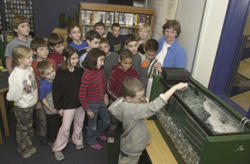|
For 200 years, there have been no native salmon in rivers and streams in the Northeast.
Mary Kay McClosky's third-grade class at Becket-Washington Elementary School wants to change that.
The two dozen youngsters in McClosky's class have been carefully raising 299 salmon "fry" for eventual release into the Yokum Brook. Originally, there were 300 salmon eggs, but one embryo didn't make it.
The project is part of the Atlantic Salmon Egg Restoration Pro-gram, an 11-year-old program sponsored by Trout Unlimited, a national organization that promotes outdoor sports.
Trout Unlimited is working in conjunction with the Atlantic Salmon Restoration Program, a 30-year-old federal program in New Hampshire, Connecticut, Vermont and Massachusetts. The plan has been to reintroduce salmon into the streams of New England. The salmon would then make their way down to the Atlantic Ocean to live, and return in a few years to spawn where they were born, thus restocking the streams naturally.
For at least 350 years, according to the DFW Web site, Atlantic salmon were a staple of the residents of New England. But pollution and the construction of dams for industry and drinking water eventually destroyed the salmon population. By the late 1800s, the salmon population was almost destroyed in the Northeast.
For the past several decades, the federal government has been trying to restore the salmon population by stocking local rivers and streams. In many cases, dams that would prevent the fish from returning to their habitat were breached or modified to allow the fish to negotiate them.
"People built dams to catch the salmon, and they gradually died out," explained third-grader Alexander Keefner. "They weren't in the rivers anymore."
The third-grade pupils are not the only ones stocking the brook, by the way. Volunteers working with the state Department of Fisheries and Wildlife annually dump about 20,000 fry into the brook, according to Caleb Slater, who is the coordinator of the local Salmon Restoration Project. The state annually introduces about 2 million fry into waterways around Massachusetts, he said.
But Becket-Washington is the first county school to be involved in the egg restoration project, said McClosky. Slater said about 36 schools statewide help the state out.
"It's a good project for the students because this promotes public awareness for the program, and it's a good science project," Slater said.
The class also is working in tandem with the Massachusetts River Restoration Program and the Yokum Brook Restoration Program. Those organizations, in conjunction with the state, have already removed Silk Dam, which is farther up the river. Work on breaching Ballou Dam, which is on the part of Yokum Brook next to the school, to provide access for the salmon, is expected to begin soon, Slater said.
"We want the salmon to have an environment where they can thrive," said Erin Grogan, another third-grader.
McClosky got a grant from the Environmental Protection Agency to purchase the fish eggs and the educational materials in February. She pointed out that the pupils are tracking the cycle of the fish, and also learning the ecological makeup of rivers and streams as part of their classroom work.
"We have a huge advantage because the brook is almost on our doorstep," she said.
When the fry are dumped into the stream, according to third-grader Nicholas Dargie, "they'll go to the Atlantic Ocean. They swim down river to a bigger river and then a bigger river and then the ocean."
"Salmon can live in fresh water and salt water, which is what makes them unique," said Vincent Quadrozzi, another member of the class.
Food supply
The newly hatched salmon are living under a rock-strewn bed in a temperature-controlled aquarium, McClosky said. They are living on food in their yolk sacs, located on their bodies. In a few weeks, the fish will be old enough to feed, and the students are raising brine shrimp to provide the food.
McClosky expects the salmon fry to be mature enough to release into the brook in a few weeks. But, noted third-grader Lane Grogan, that does not mean the experiment, is over. After the fry are dumped into the stream, "we'll raise them until they leave. Then we have to wait until they come back and lay more eggs."
Slater said that, so far, the number of salmon that return is extremely low, on the order of 50 or so a year. The changing ecology of the Atlantic Ocean, which is getting warmer every year, may have something to do with the low return.
"But we do get some fish back," he said. "So we must be doing something right."
Top
|
